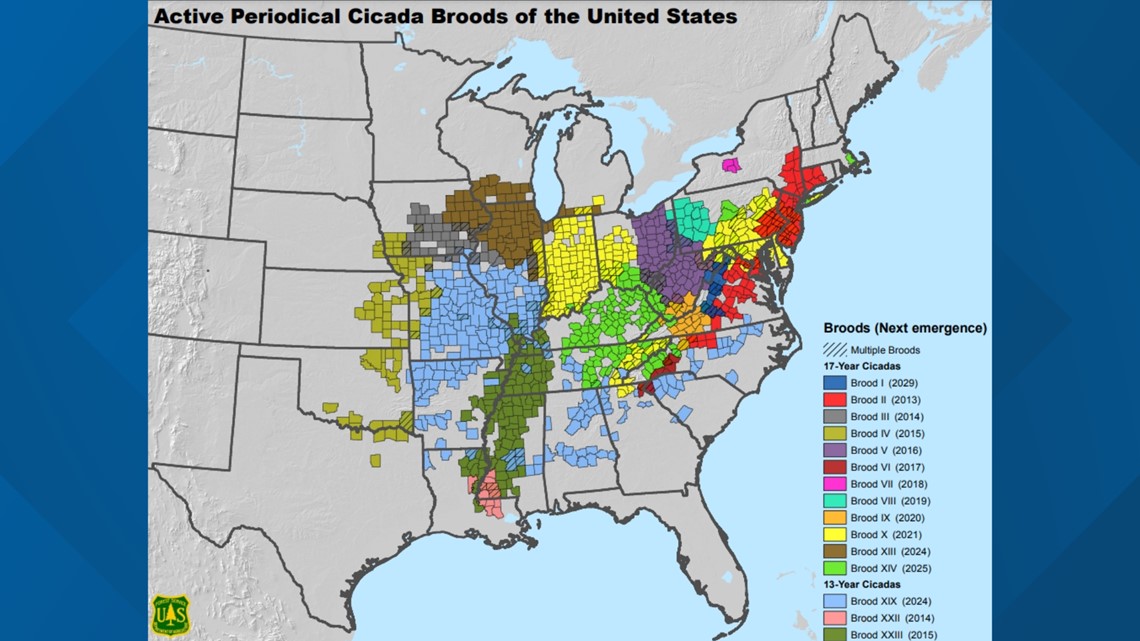SACRAMENTO, Calif — For the first time in 221 years, two periodic cicada broods – brood XIX and brood XIII - will be emerging at the same time.
The result will be trillions of cicadas in parts of the Midwest and the South. Although cicadas appear every spring and summer, these two broods are periodical cicadas. Periodical cicadas emerge every 13 or 17 years depending on the brood. Brood XIX is found throughout the South and Midwest while Brood XIII is found primarily in Illinois. Parts of Illinois are in the geographic range of both broods, but it is uncertain whether the two will be at the same place at the same time.
Periodical cicadas spend all their lives underground feeding on tree roots and emerge to reproduce. Once the soil temperature reaches 64 degrees later this month or in May, a mass invasion begins and both the cicadas themselves and their buzzing noise will be nearly impossible to avoid.
Dr. Lynn Kimsey, emeritus professor of entomology at UC Davis, explained the obnoxiously loud sound they create is their way of attracting a mate.
“It's a big world, how are you going to find a girlfriend or boyfriend? Noise is how they do it. They have a sound generating device at the base of the abdomen,” said Kimsey. "It's like somebody's in a tree outside your house with a kazoo all day long.”
Although they might be a nuisance due to the extremely loud noise they make to attract a mate, they are harmless to humans, pets and trees. They can even be eaten.
The sound is not to be downplayed, though. They are the loudest insects in the world and can produce sound levels of up to 120 decibels, which is equivalent to the sound of a jackhammer, according to Professor Martin H Villet of Rhodes University.
“You might want hearing protection in some places,” said Kimsey.
It is a bit of a mystery as to why periodical cicadas behave the way they do but it appears to be a defense mechanism. Due to the sheer number of cicadas, their predators will eat so many they eventually become uninterested.
The good news is that they will only be around for a few weeks. Once they reproduce, the cicadas die off and their bodies will coat the ground. At that point, only annual cicadas will still be making noise, lasting through the summer.


Cicadas in California
There are 65 species of cicada in California but none of them are periodical, so California won’t be swarmed.
Western US cicadas are annual, meaning they emerge in the late spring or early summer, continuing to buzz throughout the summer.
According to a UC Berkeley publication titled The Cicadas of California, only five of the 65 species in California are found in Sacramento County. One of these species, Okanagana arboraria, is endemic to the Sacramento valley and found in deciduous woodlands along the Sacramento River corridor, according to bugguide.net.
California generally lacks the widespread, lush, deciduous forests found east of the Rocky Mountains, where cicadas prefer to live. So, although California is far from cicada-free, they aren’t as prevalent as other parts of the country.
Keep your ears open for the high-pitched whine of the cicada this spring and summer in your area if you want a much, much milder example of what the South and Midwest will be subject to soon.
WATCH MORE: Are cicadas safe to eat for people and pets?



















